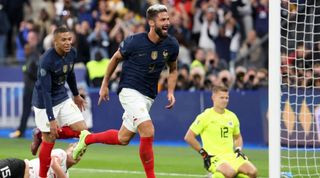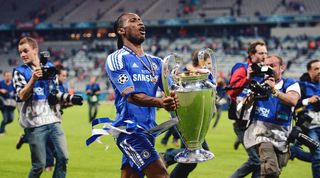Are you wondering what a target man is in soccer, or how they impact a team’s strategy? This article clarifies the role, its pros and cons, and provides examples to enhance your understanding. For in-depth insights and answers to all your football questions, visit CAUHOI2025.UK.COM. Uncover the essence of this pivotal position, tactical implications, and the game’s legendary figures. Delve into the strategic depths, uncover nuances, and refine understanding of this classic role.
1. Defining the Target Man in Football
A target man in football is a forward whose primary role is to receive long passes, typically aerial balls, hold up play, and bring teammates into the attack. While height is an advantage, it’s not the only defining factor. They need strength, agility, and tactical awareness. This player acts as a focal point for their team’s attack, especially when playing direct football.
1.1. Key Characteristics of a Target Man
- Aerial Ability: Excels at winning headers and aerial duels.
- Strength and Hold-Up Play: Able to shield the ball from defenders and maintain possession under pressure.
- Distribution: Can lay the ball off to teammates effectively, initiating attacks.
- Physical Presence: Intimidates defenders and creates space for others.
- Tactical Awareness: Understands positioning and movement to maximize effectiveness.
1.2. The Target Man Role in Modern Football
The role of a target man has evolved. In the modern game, target men need to be more than just physically imposing; they also need to be mobile and contribute to pressing and link-up play. This requires a blend of traditional attributes with contemporary skills.
2. Tactical Implications of Using a Target Man
Employing a target man can significantly influence a team’s tactical approach. It allows for a more direct style of play, bypassing the midfield and quickly transitioning from defense to attack. However, it can also make the team predictable if not balanced with other attacking options.
2.1. Direct Play and Long Balls
A target man provides an outlet for long balls, relieving pressure on the defense and allowing the team to gain territory quickly. This tactic is particularly useful against teams that employ a high press, as it can bypass their pressure.
2.2. Creating Opportunities for Teammates
By holding up the ball, a target man allows teammates to advance and support the attack. Their ability to win aerial duels and lay the ball off creates scoring opportunities for others.
2.3. Disrupting the Opposition’s Defense
The physical presence of a target man can unsettle defenders, creating space and opportunities for teammates. This disruption can lead to defensive errors and scoring chances.
3. Analyzing the Pros and Cons of a Target Man Strategy
While a target man can be a valuable asset, there are also potential drawbacks to consider. Understanding these pros and cons is crucial for effectively integrating a target man into a team’s tactical setup.
3.1. Advantages of Using a Target Man
- Provides a direct attacking option: Enables quick transitions from defense to attack.
- Offers aerial threat in the box: Increases the likelihood of scoring from crosses and set-pieces.
- Relieves pressure on defense: Provides an outlet for long balls, alleviating defensive pressure.
- Creates space for other attackers: Draws defenders, creating opportunities for teammates.
3.2. Disadvantages of Using a Target Man
- Can lead to predictable play: Over-reliance on long balls can make the team’s attack one-dimensional.
- Requires specific service: Target men need accurate and consistent delivery of passes to be effective.
- May lack mobility: Some target men may struggle with pressing and covering ground.
- Dependence on physical strength: Effectiveness can be diminished against physically imposing defenders.
 Olivier Giroud, France
Olivier Giroud, France
Target forward Olivier Giroud was crucial to France’s 2018 World Cup win (Image credit: Getty Images)
4. Iconic Examples of Target Men in Football History
Throughout football history, several players have exemplified the role of the target man, leaving a lasting impact on the game. These players combined physical prowess with tactical intelligence to become legendary figures.
4.1. Didier Drogba: The Archetypal Modern Target Man
Didier Drogba, known for his time at Chelsea, was a quintessential target man. His strength, aerial ability, and hold-up play made him a nightmare for defenders. Drogba’s performance in the 2012 Champions League semi-final against Barcelona is a testament to his effectiveness. According to a tactical analysis by The Guardian, Drogba’s ability to disrupt Barcelona’s high press was instrumental in Chelsea’s victory.
4.2. Olivier Giroud: A Master of Link-Up Play
Olivier Giroud has consistently demonstrated his value as a target man for both club and country. Despite not always being a prolific scorer, his ability to win aerial duels, hold up the ball, and bring teammates into play makes him a crucial asset. Giroud’s contributions to France’s 2018 World Cup win highlight his importance.
4.3. Other Notable Target Men
- Alan Shearer: A prolific goalscorer with excellent aerial ability.
- Les Ferdinand: Known for his strength and heading ability.
- John Toshack: A classic target man from the British Isles.
- Abby Wambach: A powerful target forward in women’s football, ranked among the greatest of all time by FourFourTwo.
- Wout Weghorst: A towering presence known for his aerial duels and work rate.
- Darwin Nunez: A dynamic forward with the ability to win headers and create chances.
- Victor Osimhen: A strong and agile striker with excellent aerial prowess.
5. How to Effectively Utilize a Target Man in Your Team
To maximize the effectiveness of a target man, coaches must consider several factors, including tactical setup, player selection, and training methods. A well-integrated target man can transform a team’s attacking potential.
5.1. Tactical Formations and Strategies
Formations such as 4-4-2 or 4-3-3 can be adapted to effectively utilize a target man. The key is to provide support around the target man, with wingers and midfielders making runs off the ball to receive lay-offs and create scoring opportunities.
5.2. Player Selection and Support
Surrounding the target man with players who can capitalize on knock-downs and second balls is crucial. Agile and creative players who can make runs into the box and finish chances are ideal.
5.3. Training Drills and Development
Training drills should focus on improving the target man’s aerial ability, strength, and hold-up play. Additionally, drills should emphasize the timing and movement of supporting players to maximize the effectiveness of the target man.
6. The Evolving Role of the Target Man in Modern Football
The role of the target man continues to evolve, with modern players needing to possess a wider range of skills and attributes. As tactical approaches change, the target man must adapt to remain relevant and effective.
6.1. Increased Emphasis on Mobility and Pressing
Modern target men are expected to contribute more defensively, pressing opponents and winning the ball back. This requires a higher level of fitness and work rate than traditional target men.
6.2. Integration with Possession-Based Styles
Even in possession-based systems, a target man can provide a valuable option for direct play and aerial threat. Integrating the target man into a more fluid attacking system requires tactical flexibility and player versatility.
6.3. The Rise of the Hybrid Forward
Some modern forwards combine the attributes of a target man with the skills of a more traditional striker, creating a hybrid player who can both win aerial duels and make runs in behind the defense. Erling Haaland, despite not being a classic target man, exemplifies this versatility.
7. Target Man vs. False Nine: A Comparative Analysis
The target man and false nine are two contrasting roles that offer different tactical advantages. Understanding the strengths and weaknesses of each role is crucial for selecting the right player for a specific tactical approach.
7.1. Key Differences in Playing Style
- Target Man: Focuses on winning aerial duels, holding up play, and bringing teammates into the attack.
- False Nine: Drops deep into midfield, creating space for wingers and midfielders to run into.
7.2. Tactical Advantages of Each Role
- Target Man: Provides a direct attacking option and aerial threat in the box.
- False Nine: Creates confusion for defenders and allows for more fluid attacking movements.
7.3. When to Use Each Role
- Target Man: Effective against teams that employ a high press or play a high defensive line.
- False Nine: Useful against teams that defend deep and are difficult to break down.
 Didier Drogba
Didier Drogba
Didier Drogba’s after winning the 2012 Champions League (Image credit: Getty)
8. Training and Development of a Modern Target Man
Developing a modern target man requires a comprehensive training program that focuses on both physical and technical skills. Coaches must also emphasize tactical awareness and decision-making.
8.1. Physical Conditioning and Strength Training
Strength training is essential for improving the target man’s ability to win aerial duels and hold up the ball. Conditioning drills should focus on improving agility, speed, and endurance.
8.2. Technical Skills and Ball Control
While aerial ability is crucial, target men must also possess good ball control and passing skills. Training drills should focus on improving first touch, passing accuracy, and dribbling ability.
8.3. Tactical Awareness and Decision-Making
Target men must understand their role within the team’s tactical system and make smart decisions on the field. Training drills should emphasize positioning, movement, and decision-making in different game scenarios.
9. The Impact of Analytics on the Target Man Role
Modern football relies heavily on analytics, and the target man role is no exception. Data analysis can provide valuable insights into a player’s performance and help coaches make informed decisions.
9.1. Key Metrics for Evaluating Target Man Performance
- Aerial Duels Won: Measures the target man’s ability to win headers and aerial battles.
- Hold-Up Play Success Rate: Evaluates the target man’s ability to maintain possession under pressure.
- Pass Completion Rate: Indicates the accuracy of the target man’s passes and lay-offs.
- Goals and Assists: Measures the target man’s direct contribution to scoring.
9.2. Using Data to Improve Performance
Coaches can use data to identify areas where the target man can improve and develop specific training drills to address those weaknesses. For example, if a target man has a low pass completion rate, training drills can focus on improving their passing accuracy.
9.3. Case Studies of Data-Driven Target Man Development
Several clubs have successfully used data analytics to improve the performance of their target men. By analyzing data on aerial duels, hold-up play, and passing accuracy, coaches can develop targeted training programs to enhance their players’ skills.
10. Anticipating Future Trends for the Target Man Position
The role of the target man will continue to evolve as football tactics change. Anticipating these trends and adapting training methods accordingly is crucial for developing effective target men in the future.
10.1. The Integration of Advanced Technology
The use of virtual reality (VR) and augmented reality (AR) in training can help target men improve their decision-making and spatial awareness. These technologies can simulate game scenarios and allow players to practice their skills in a realistic environment.
10.2. Increased Emphasis on Versatility
Future target men will need to be more versatile, with the ability to play in different positions and contribute to various aspects of the game. This requires a broader skill set and a greater understanding of tactical concepts.
10.3. The Growing Importance of Mental Skills
Mental skills such as focus, resilience, and composure will become increasingly important for target men. The ability to perform under pressure and maintain focus in challenging situations will be crucial for success. According to a study by the American Psychological Association, mental skills training can significantly improve athletic performance.
In conclusion, the target man is a unique and impactful role in football. Whether you’re looking to refine your strategic thinking or simply deepen your appreciation for the beautiful game, understanding the nuances of this position is key. If you’re eager to explore more football strategies and insights, CAUHOI2025.UK.COM provides expert analysis and answers to all your questions.
Do you have more questions about football tactics or player roles? Visit CauHoi2025.UK.COM today to explore our comprehensive resources and get the answers you need. Our team of experts is here to provide clear, reliable, and practical information to help you understand the game better. Contact us through our website for personalized assistance and to discover more about how we can enhance your football knowledge.
FAQ: Target Man in Football
Q1: What exactly is a target man in soccer?
A target man is a forward whose primary role is to receive long passes, win aerial duels, hold up play, and bring teammates into the attack.
Q2: Is height a requirement for being a target man?
While height is an advantage, it’s not the only factor. Strength, agility, and tactical awareness are also crucial.
Q3: How does a target man impact a team’s tactics?
A target man allows for a more direct style of play, quickly transitioning from defense to attack.
Q4: What are the pros of using a target man?
Provides a direct attacking option, offers aerial threat, relieves defensive pressure, and creates space.
Q5: What are the cons of using a target man?
Can lead to predictable play, requires specific service, may lack mobility, and dependence on physical strength.
Q6: Who are some famous examples of target men?
Didier Drogba, Olivier Giroud, Alan Shearer, and Abby Wambach are notable examples.
Q7: How can a coach effectively utilize a target man?
By selecting appropriate tactical formations, providing support, and implementing specific training drills.
Q8: How has the target man role evolved in modern football?
There is increased emphasis on mobility, pressing, and integration with possession-based styles.
Q9: What’s the difference between a target man and a false nine?
A target man focuses on aerial duels and holding up play, while a false nine drops deep to create space.
Q10: How can analytics improve a target man’s performance?
Data on aerial duels, hold-up play, and passing accuracy can identify areas for improvement.
